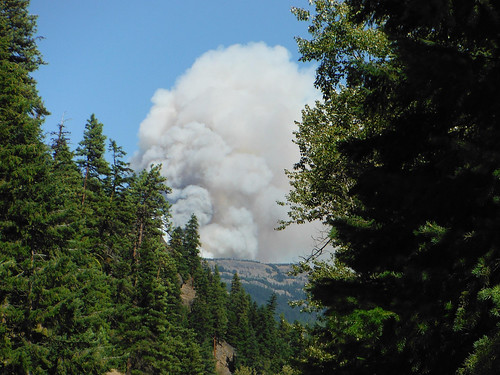
A massive column of smoke rises from a forest fire. Today’s rapidly changing conditions present challenges for forest managers when determining what plant species to replant after a disturbance like a wildland fire. Photo credit: US Forest Service
Forests are changing in ways they’ve never experienced before because today’s growing conditions are different from anything in the past. The climate is changing at an unprecedented rate, exotic diseases and pests are present, and landscapes are fragmented by human activity often occurring at the same time and place.
The current drought in California serves as a reminder and example that forests of the 21st century may not resemble those from the 20th century. When replanting a forest after disturbances, does it make sense to try to reestablish what was there before? Or, should we find re-plant material that might be more appropriate to current and future conditions of a changing environment?
Restoration efforts on U.S. Forest Service managed lands call for the use of locally adapted and appropriate native seed sources. The science-based process for selecting these seeds varies, but in the past, managers based decisions on the assumption that present site conditions are similar to those of the past.
This may no longer be the case.
Forest managers are already altering the species they use when replanting since species like chestnut, elm, butternut and the ashes have been, and are being, decimated by exotic diseases and pests. We don’t yet know what a changing climate will bring.
Forest Service scientists and geneticists are spearheading efforts to provide tools to adapt reforestation practices for changing conditions. These practices include selecting seed of proper species and location, choosing trees resistant to disease and pests, using the appropriate seedling type, controlling vegetation, and identifying proper spacing to plant tree seedlings.
Making an accurate prediction of which plants will succeed in a new environment is difficult, so geneticists employ a strategy that is not unlike your retirement portfolio: we diversify. By increasing the genetic diversity on a site, either by adding novel species or seed sources within species, we increase the chance that suitable genetic material will exist in the new environment. But we don’t want to add any ole diversity, we try to add species and seed sources that would have the best chance of thriving in a new environment.
Our forests are confronting challenges from a changing climate, diseases, insects, and human disturbance. While we can’t be sure of what the future will hold, we use science to better understand the future and then try to consider that future when we plant and manage our forests.
No comments:
Post a Comment
Note: Only a member of this blog may post a comment.